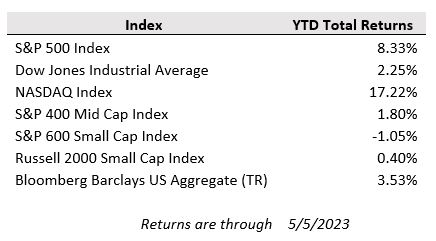Despite a strong market rally on Friday following another upbeat labor market report, U.S. equity markets dipped lower last week as investor sentiment was weighed down by jitters over the stability of the regional banking space and the future of the Federal Reserve's monetary policy. For the week, the S&P 500 and Dow Jones lost 0.8% and 1.2%, respectively, but the tech-heavy Nasdaq Composite managed to stay positive with a 0.1% gain.
Most of the spotlight was dominated by a handful of regional lenders, which led to concerns that the banking crisis was still unfolding. The week began with First Republic Bank being taken over by JPMorgan under a government-led deal - a rescue that was engineered after the bank disclosed over $70B of quarterly deposit outflows. On Thursday, shares of two other west-coast regional banks, PacWest Bancorp and Western Alliance, plummeted amid reports of both lenders exploring strategic options to shore up capital, though Western Alliance later refuted those claims as false. Both banks have asserted that deposit pressures have eased significantly in recent weeks, and the stocks rebounded on Friday and into this week’s early trading as fears have stabilized a bit.
Last week also saw the Fed's latest monetary policy committee meeting, which culminated in another 25-basis point rate hike. Fed chair Powell in his post-decision press conference said that policymakers would continue to take a data-dependent approach to future rate hikes. On the topic of rate cuts, Powell said inflation is not expected to come down quickly and that near-term rate cuts likely would not be appropriate.
On the economic front, there were several data points on the labor market that pointed to continued resilience and calmed some worries that the Fed’s rate-hiking campaign could lead to the economy cooling too fast and slipping into recession. ADP's measure of private payrolls in April came in higher than expected, and so did the number of Americans filing for weekly jobless claims. Friday's nonfarm payrolls report showed robust job additions in April with a nonfarm payroll increase of 253k against expectations for a 157k reading, though the gains for the prior two months were revised down. The unemployment rate ticked down to just 3.4%.
Forecasters have repeatedly underestimated the strength of the post-pandemic labor market. They have undershot the payroll number 12 straight times, assuming companies would pull back on hiring as the Fed raised borrowing rates to tame inflation. Instead, employers have added roughly 4.5 million jobs since the central bank started increasing interest rates in March 2022. That comes despite waves of layoffs in the tech and retail sectors, respectively.
Further jobs strength over the next few months could still influence the Fed’s interest rate policy. The Fed signaled that Wednesday’s rate increase would be its last for a while, but the central bank is determined to lower inflation to its 2 percent target. It has resolved to bring prices under control, even at the expense of broader macro conditions, specifically calling out the still tight labor market.
The April inflation report will be the topic in focus this week, with headline consumer inflation forecast to increase 0.4% month-over-month and be up 5.0% from a year ago. Energy prices are likely to have risen during the month and food prices are not anticipated to show the deceleration that they did in March.


